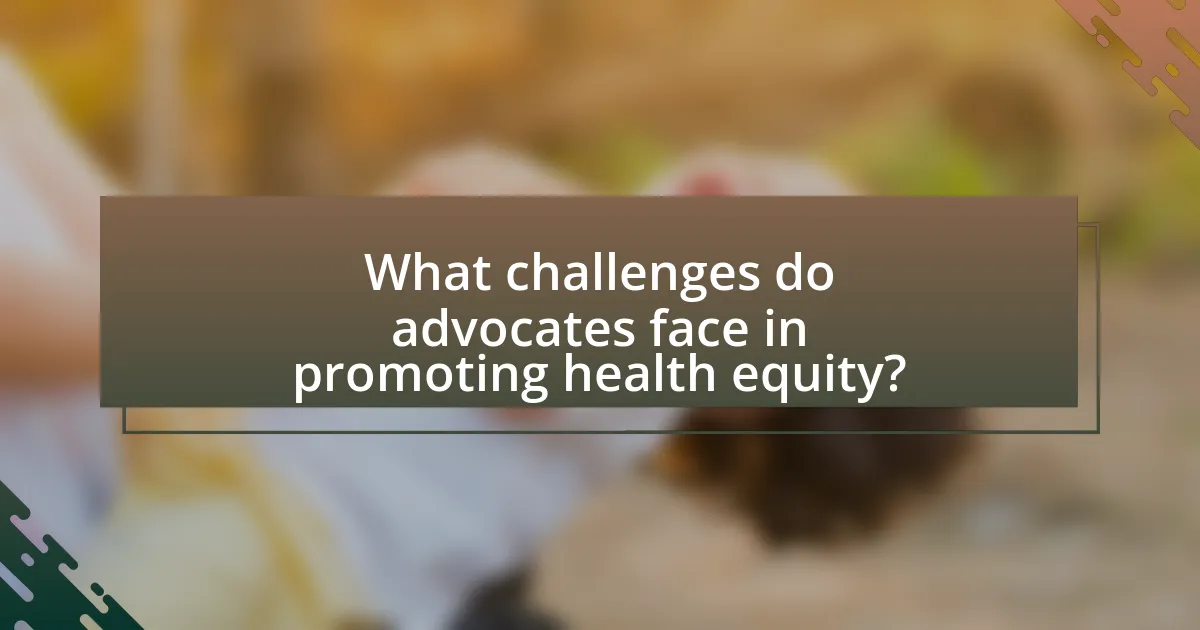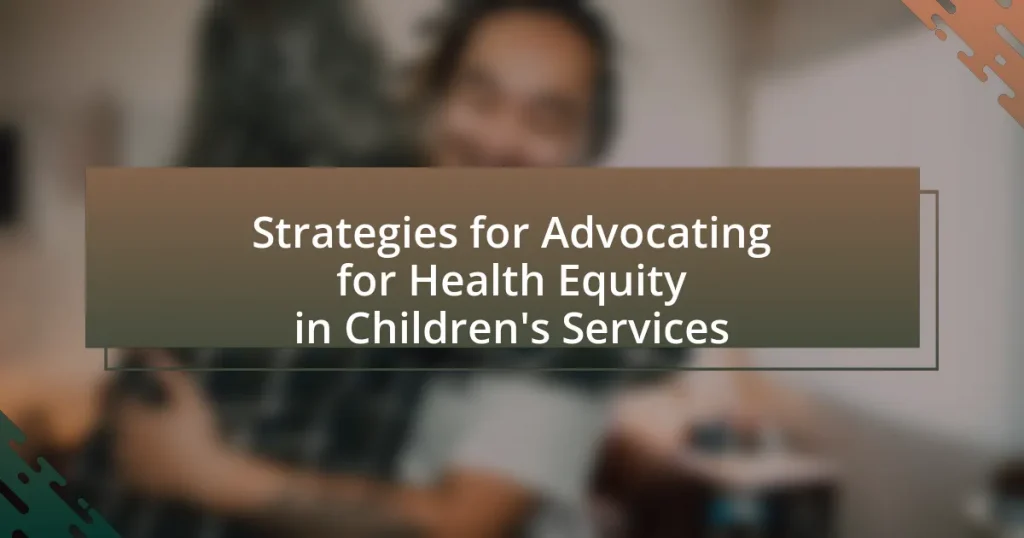The article focuses on strategies for advocating for health equity in children’s services, emphasizing the importance of community partnerships, policy changes, and access to quality healthcare. It outlines how community engagement enhances advocacy efforts by fostering trust and collaboration, while also detailing methods to involve families in advocacy initiatives. The role of data in identifying health disparities and informing policy decisions is highlighted, alongside the necessity of targeted policy changes to address systemic barriers. Additionally, the article discusses challenges advocates face, funding limitations, and best practices for building effective coalitions to ensure sustainable health equity initiatives.
What are the key strategies for advocating for health equity in children’s services?
Key strategies for advocating for health equity in children’s services include building community partnerships, promoting policy changes, and ensuring access to quality healthcare. Community partnerships enhance outreach and engagement, allowing for tailored services that meet specific needs. Promoting policy changes at local, state, and national levels can address systemic barriers to health equity, as evidenced by initiatives like the Affordable Care Act, which aimed to reduce disparities in healthcare access. Ensuring access to quality healthcare involves advocating for resources and services that are culturally competent and financially accessible, which is critical given that children from low-income families are disproportionately affected by health inequities.
How can community engagement enhance advocacy efforts?
Community engagement enhances advocacy efforts by fostering trust and collaboration between advocates and the community they serve. When community members actively participate in advocacy initiatives, they provide valuable insights into their needs and challenges, which can inform more effective strategies. For instance, research by the Robert Wood Johnson Foundation indicates that community-driven advocacy leads to more relevant health policies, as local voices shape the agenda. This participatory approach not only amplifies the concerns of marginalized populations but also mobilizes grassroots support, increasing the likelihood of successful policy changes that promote health equity in children’s services.
What methods can be used to involve families in advocacy?
To involve families in advocacy, organizations can implement methods such as providing education and training on advocacy skills, facilitating family-led initiatives, and creating platforms for family voices to be heard. Education equips families with the knowledge to effectively advocate for their needs, while family-led initiatives empower them to take charge of advocacy efforts. Additionally, platforms like community forums or advisory boards ensure that families can share their experiences and influence decision-making processes. Research indicates that when families are actively engaged in advocacy, it leads to improved health outcomes for children, as evidenced by studies showing that family involvement in policy discussions results in more responsive services.
How does collaboration with local organizations strengthen advocacy?
Collaboration with local organizations strengthens advocacy by leveraging community knowledge and resources to amplify voices and influence policy. Local organizations possess deep insights into the specific needs and challenges faced by their communities, which can inform advocacy strategies and ensure they are relevant and effective. For instance, partnerships can enhance outreach efforts, as local organizations often have established trust and relationships within the community, leading to increased engagement and participation in advocacy initiatives. Additionally, collaborative efforts can pool resources, allowing for more comprehensive campaigns that can address systemic issues more effectively. Research indicates that community-based advocacy efforts, such as those led by local organizations, can lead to more sustainable policy changes, as they are rooted in the lived experiences of those affected.
What role does data play in advocating for health equity?
Data plays a crucial role in advocating for health equity by providing evidence to identify disparities and inform policy decisions. It enables stakeholders to analyze health outcomes across different populations, revealing inequities in access to care, treatment, and health resources. For instance, the Centers for Disease Control and Prevention (CDC) reports that data on social determinants of health can highlight how factors like income, education, and geography affect health outcomes, guiding targeted interventions. Furthermore, data-driven advocacy can mobilize resources and support by illustrating the need for equitable health policies, as seen in initiatives that leverage health statistics to address childhood obesity disparities among different socioeconomic groups.
How can data be used to identify health disparities among children?
Data can be used to identify health disparities among children by analyzing demographic, socioeconomic, and health outcome information to reveal inequities in access to care and health status. For instance, data from the National Survey of Children’s Health indicates that children from low-income families are more likely to experience chronic health conditions compared to their higher-income counterparts. By examining this data, researchers can pinpoint specific populations that are disproportionately affected by health issues, enabling targeted interventions and policy changes to address these disparities.
What types of data are most effective for advocacy purposes?
Quantitative data, such as statistics on health disparities, and qualitative data, like personal testimonies, are the most effective for advocacy purposes. Quantitative data provides measurable evidence of issues, such as the fact that children from low-income families are 2.5 times more likely to experience health problems compared to their wealthier peers. Qualitative data, including stories from affected families, humanizes these statistics and can evoke emotional responses, making the case for change more compelling. Together, these data types create a robust narrative that can influence policymakers and stakeholders in the context of health equity in children’s services.
Why is policy change crucial for health equity in children’s services?
Policy change is crucial for health equity in children’s services because it directly addresses systemic barriers that disproportionately affect marginalized populations. Effective policy reforms can ensure equitable access to healthcare resources, improve service delivery, and allocate funding to underserved communities. For instance, the American Academy of Pediatrics emphasizes that policy initiatives aimed at social determinants of health can significantly reduce disparities in health outcomes among children. By implementing evidence-based policies, such as expanding Medicaid coverage or increasing funding for community health programs, disparities in access and quality of care can be minimized, leading to improved health equity for all children.
What specific policies should advocates focus on changing?
Advocates should focus on changing policies related to access to healthcare, funding for children’s mental health services, and the integration of social determinants of health into children’s health programs. Access to healthcare policies should ensure that all children, regardless of socioeconomic status, have affordable and timely access to necessary medical services. Funding for children’s mental health services is critical, as studies show that one in five children experiences a mental health disorder, yet many lack access to appropriate care. Integrating social determinants of health into children’s health programs is essential, as research indicates that factors such as housing stability, food security, and education significantly impact children’s health outcomes.
How can advocates effectively communicate policy needs to stakeholders?
Advocates can effectively communicate policy needs to stakeholders by utilizing clear, data-driven messaging that highlights the importance of health equity in children’s services. This approach involves presenting compelling evidence, such as statistics on health disparities among children, to illustrate the urgency of the policy needs. For instance, a report from the Centers for Disease Control and Prevention indicates that children from low-income families are more likely to experience health issues, underscoring the necessity for targeted policy interventions. By framing the conversation around these concrete data points, advocates can engage stakeholders in meaningful dialogue and foster a shared understanding of the critical issues at hand.

What challenges do advocates face in promoting health equity?
Advocates face significant challenges in promoting health equity, primarily due to systemic barriers such as socioeconomic disparities, institutional racism, and inadequate access to resources. These barriers hinder the ability of marginalized communities to receive equitable healthcare services. For instance, according to the American Public Health Association, communities of color experience higher rates of chronic diseases and lower access to healthcare, which underscores the impact of these systemic issues. Additionally, advocates often encounter resistance from policymakers who may prioritize economic interests over health equity initiatives, further complicating efforts to implement effective strategies.
How can systemic barriers be addressed in advocacy efforts?
Systemic barriers can be addressed in advocacy efforts by implementing targeted policy changes, fostering community engagement, and utilizing data-driven approaches. Targeted policy changes involve identifying specific laws or regulations that perpetuate inequities and advocating for their reform, such as advocating for increased funding for underserved communities. Community engagement is crucial, as involving affected populations in the advocacy process ensures that their voices and needs are represented, which can lead to more effective solutions. Data-driven approaches, such as collecting and analyzing health disparities data, provide evidence to support advocacy efforts and highlight the urgency of addressing systemic barriers. For instance, the Robert Wood Johnson Foundation emphasizes the importance of using data to inform policy decisions and drive equitable health outcomes.
What are common systemic barriers to health equity in children’s services?
Common systemic barriers to health equity in children’s services include socioeconomic disparities, lack of access to quality healthcare, and inadequate funding for services. Socioeconomic disparities often lead to unequal health outcomes, as children from low-income families may face challenges such as food insecurity and unstable housing, which negatively impact their health. Additionally, lack of access to quality healthcare services, particularly in rural or underserved urban areas, limits children’s ability to receive necessary medical attention. Inadequate funding for children’s health programs further exacerbates these issues, resulting in insufficient resources to address the diverse needs of children, particularly those from marginalized communities. These barriers collectively hinder the achievement of health equity in children’s services.
How can advocates work to dismantle these barriers?
Advocates can dismantle barriers to health equity in children’s services by implementing targeted policy changes and community engagement initiatives. For instance, they can lobby for legislation that addresses systemic inequalities, such as the Affordable Care Act, which expanded access to healthcare for millions of children. Additionally, advocates can collaborate with local organizations to raise awareness about health disparities and mobilize community resources, thereby fostering an inclusive environment that supports equitable access to services. Research indicates that community-driven approaches, such as those outlined in the “Community Health Needs Assessment” by the American Hospital Association, effectively identify and address specific barriers faced by underserved populations.
What are the implications of funding limitations on advocacy?
Funding limitations significantly hinder advocacy efforts by restricting resources necessary for effective outreach, research, and program implementation. When funding is inadequate, organizations may struggle to maintain staff, leading to reduced capacity for advocacy initiatives. For instance, a study by the Center for American Progress found that non-profit organizations with limited funding often face challenges in mobilizing community support and conducting essential advocacy campaigns, which are crucial for influencing policy changes. Additionally, funding constraints can limit the ability to gather and analyze data, weakening the evidence base needed to support advocacy claims. This ultimately diminishes the impact of advocacy efforts aimed at promoting health equity in children’s services.
How can advocates secure funding for health equity initiatives?
Advocates can secure funding for health equity initiatives by building strong partnerships with community organizations and leveraging data to demonstrate the need for funding. Collaborating with local stakeholders allows advocates to create comprehensive proposals that highlight the impact of health disparities on children’s services. For instance, a study by the Robert Wood Johnson Foundation found that targeted funding for health equity initiatives can lead to improved health outcomes in underserved populations. By presenting compelling evidence and aligning their goals with funders’ priorities, advocates can effectively attract financial support for their initiatives.
What alternative funding sources can be explored?
Alternative funding sources that can be explored include grants from foundations, crowdfunding platforms, corporate sponsorships, and government programs. Foundations such as the Robert Wood Johnson Foundation and the W.K. Kellogg Foundation provide grants specifically aimed at health equity initiatives. Crowdfunding platforms like GoFundMe and Kickstarter allow individuals and organizations to raise funds directly from the public for specific projects. Corporate sponsorships can be pursued by partnering with businesses that align with health equity goals, while government programs often offer funding opportunities through initiatives aimed at improving children’s health services. These sources are increasingly recognized as viable options for supporting health equity efforts in children’s services.

What best practices should advocates follow for effective health equity initiatives?
Advocates should prioritize community engagement and collaboration for effective health equity initiatives. Engaging with the community ensures that the voices of those affected by health disparities are heard and incorporated into decision-making processes. Collaborative efforts with local organizations, healthcare providers, and policymakers can enhance resource sharing and create a unified approach to addressing health inequities. Research indicates that initiatives involving community participation are more likely to succeed; for instance, a study published in the American Journal of Public Health found that community-driven interventions led to a 30% increase in health service utilization among marginalized populations.
How can advocates build effective coalitions for health equity?
Advocates can build effective coalitions for health equity by fostering inclusive partnerships among diverse stakeholders, including community organizations, healthcare providers, and policymakers. This collaborative approach ensures that multiple perspectives are represented, enhancing the coalition’s ability to address systemic health disparities. Research indicates that coalitions with diverse membership are more successful in mobilizing resources and influencing policy changes, as seen in the “Community-Campus Partnerships for Health” initiative, which emphasizes the importance of community engagement in health equity efforts. By leveraging shared goals and resources, advocates can create a unified front that effectively addresses the social determinants of health impacting children and their families.
What are the key components of a successful coalition?
The key components of a successful coalition include a shared vision, strong leadership, diverse membership, effective communication, and a clear action plan. A shared vision aligns the coalition’s goals and motivates members to work collaboratively towards common objectives. Strong leadership facilitates decision-making and fosters commitment among members. Diverse membership brings various perspectives and resources, enhancing the coalition’s effectiveness. Effective communication ensures transparency and engagement, while a clear action plan outlines specific strategies and responsibilities, guiding the coalition’s efforts. Research indicates that coalitions with these components are more likely to achieve their goals, as evidenced by successful initiatives in public health and community development.
How can coalition members maintain engagement and motivation?
Coalition members can maintain engagement and motivation by establishing clear goals and fostering open communication. Clear goals provide a shared vision that aligns members’ efforts, while open communication encourages collaboration and feedback, enhancing commitment. Research indicates that coalitions with defined objectives and regular updates experience higher member satisfaction and retention rates, as seen in the study “Coalition Effectiveness: A Review of the Literature” by Butterfoss and Kegler, which highlights the importance of structured communication in sustaining member involvement.
What strategies can be employed to raise awareness about health equity?
To raise awareness about health equity, targeted community engagement strategies can be employed. These strategies include organizing educational workshops that inform community members about health disparities, utilizing social media campaigns to disseminate information widely, and collaborating with local organizations to amplify outreach efforts. For instance, a study by the Robert Wood Johnson Foundation found that community-based initiatives significantly improve public understanding of health equity issues, demonstrating the effectiveness of direct engagement in raising awareness.
How can social media be leveraged for advocacy campaigns?
Social media can be leveraged for advocacy campaigns by facilitating widespread communication, mobilizing supporters, and amplifying messages. Advocacy organizations can utilize platforms like Twitter, Facebook, and Instagram to share impactful stories, engage with the community, and raise awareness about health equity issues affecting children’s services. For instance, a study by the Pew Research Center found that 69% of adults in the U.S. use social media, making it an effective tool for reaching diverse audiences. Additionally, campaigns can use targeted ads to reach specific demographics, ensuring that messages resonate with those most affected by health disparities. By employing hashtags and encouraging user-generated content, advocacy groups can create a sense of community and drive collective action, further enhancing their campaign’s visibility and impact.
What role do community events play in raising awareness?
Community events play a crucial role in raising awareness by providing a platform for education, engagement, and collaboration among diverse groups. These events facilitate direct interaction between community members and health advocates, allowing for the dissemination of vital information regarding health equity issues affecting children. For instance, studies have shown that community gatherings can increase knowledge about health resources and services by up to 40%, as they create opportunities for dialogue and shared experiences. Additionally, community events often attract local media coverage, further amplifying the message and reaching a broader audience, which is essential for fostering a collective understanding of health disparities and mobilizing action towards equity in children’s services.
What practical steps can advocates take to ensure sustainability of their efforts?
Advocates can ensure the sustainability of their efforts by building strong coalitions with diverse stakeholders. Collaborating with community organizations, government agencies, and private sector partners enhances resource sharing and amplifies advocacy messages. Research shows that coalitions can increase the effectiveness of advocacy efforts by pooling expertise and resources, as demonstrated in the “Coalition Building for Health Equity” study published by the American Public Health Association, which highlights successful partnerships leading to sustained health initiatives. Additionally, securing ongoing funding through grants and donations is crucial; studies indicate that organizations with diversified funding sources are more resilient and capable of maintaining their programs over time. Engaging in continuous community education and outreach fosters public support and awareness, which is vital for long-term advocacy success.
